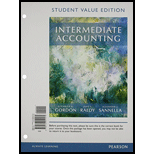
Intermediate Accounting - Myaccountinglab - Pearson Etext Access Card Student Value Edition
1st Edition
ISBN: 9780134047430
Author: Elizabeth A. Gordon, Jana S. Raedy, Alexander J. Sannella
Publisher: PEARSON
expand_more
expand_more
format_list_bulleted
Concept explainers
Question
Chapter 17, Problem 17.14E
a.
To determine
To prepare:
Given information:
Taxable income of firm is $405,000 in year 1.
Taxable income in year 2 was $220,000.
Loss in year 3 is $975,000.
Tax rate is 34%
b.
To determine
To prepare: Partial income statement for year 3.
Expert Solution & Answer
Want to see the full answer?
Check out a sample textbook solution
Students have asked these similar questions
Please provide the answer to this general accounting question with proper steps.
Can you solve this general accounting problem with appropriate steps and explanations?
Please provide the answer to this general accounting question using the right approach.
Chapter 17 Solutions
Intermediate Accounting - Myaccountinglab - Pearson Etext Access Card Student Value Edition
Ch. 17 - Prob. 17.1QCh. 17 - When will income tax expense and income taxes...Ch. 17 - Will permanent differences cause the effective tax...Ch. 17 - When do permanent differences arise?Ch. 17 - How are deferred tax assets and deferred tax...Ch. 17 - Prob. 17.6QCh. 17 - Prob. 17.7QCh. 17 - Prob. 17.8QCh. 17 - Prob. 17.9QCh. 17 - How does a firm determine the need for a valuation...
Ch. 17 - Prob. 17.11QCh. 17 - Prob. 17.12QCh. 17 - Prob. 17.13QCh. 17 - How does an entity account for uncertain tax...Ch. 17 - Prob. 17.15QCh. 17 - Prob. 17.16QCh. 17 - Do U.S. GAAP and IFRS classify deferred tax...Ch. 17 - Prob. 17.18QCh. 17 - Cavan Company prepared the following...Ch. 17 - Prob. 17.2MCCh. 17 - Prob. 17.3MCCh. 17 - Prob. 17.4MCCh. 17 - Prob. 17.5MCCh. 17 - Prob. 17.6MCCh. 17 - Prob. 17.7MCCh. 17 - Prob. 17.1BECh. 17 - Income Taxes Payable. Limmox Company has...Ch. 17 - Permanent Differences. Simmox Company's income...Ch. 17 - Permanent Differences. Plimmox Company's income...Ch. 17 - Permanent Differences, Reconciliation of Statutory...Ch. 17 - Prob. 17.6BECh. 17 - Prob. 17.7BECh. 17 - Prob. 17.8BECh. 17 - Prob. 17.9BECh. 17 - Prob. 17.10BECh. 17 - Temporary Differences, Deferred Tax Liability....Ch. 17 - Temporary Differences. Deferred Tax Asset....Ch. 17 - Temporary Differences, Deferred Tax Asset. Using...Ch. 17 - Prob. 17.14BECh. 17 - Realizability of Deferred Assets. Maves, Inc....Ch. 17 - Prob. 17.16BECh. 17 - Prob. 17.17BECh. 17 - Prob. 17.18BECh. 17 - Prob. 17.19BECh. 17 - Prob. 17.20BECh. 17 - Prob. 17.21BECh. 17 - Prob. 17.22BECh. 17 - Prob. 17.23BECh. 17 - Prob. 17.24BECh. 17 - Prob. 17.25BECh. 17 - Prob. 17.26BECh. 17 - Prob. 17.27BECh. 17 - Prob. 17.1ECh. 17 - Prob. 17.2ECh. 17 - Prob. 17.3ECh. 17 - Prob. 17.4ECh. 17 - Temporary Differences, Deferred Tax Assets and...Ch. 17 - Temporary Differences, Deferred Tax Assets and...Ch. 17 - Prob. 17.7ECh. 17 - Prob. 17.8ECh. 17 - Change in Tax Rates, Permanent Difference,...Ch. 17 - Prob. 17.10ECh. 17 - Prob. 17.11ECh. 17 - Net Operating Loss, Carryback. Phlash Photo Labs,...Ch. 17 - Net Operating Loss, Carryforward. Loggins Lumber...Ch. 17 - Prob. 17.14ECh. 17 - Prob. 17.15ECh. 17 - Net Operating Loss, Carryforward, Tax Rate Change....Ch. 17 - Prob. 17.17ECh. 17 - Prob. 17.18ECh. 17 - Uncertain Tax Positions. Lewis Eagle Corporation...Ch. 17 - Uncertain Tax Positions. Based on the information...Ch. 17 - Prob. 17.21ECh. 17 - Prob. 17.1PCh. 17 - Temporary Differences, Deferred Tax Liabilities,...Ch. 17 - Prob. 17.3PCh. 17 - Prob. 17.4PCh. 17 - Temporary Differences, Deferred Tax Liabilities,...Ch. 17 - Prob. 17.6PCh. 17 - Prob. 17.7PCh. 17 - Prob. 17.8PCh. 17 - Prob. 17.9PCh. 17 - Prob. 17.10PCh. 17 - Prob. 17.11PCh. 17 - Prob. 17.12PCh. 17 - Permanent Differences, Temporary Tax Differences,...Ch. 17 - Prob. 1JCCh. 17 - Prob. 2JCCh. 17 - Prob. 1FSACCh. 17 - Prob. 1SSCCh. 17 - Prob. 2SSCCh. 17 - Prob. 3SSCCh. 17 - Scene 1: The concept of the deferred tax liability...Ch. 17 - Basis for Conclusions Case 2: Uncertain Tax...
Knowledge Booster
Learn more about
Need a deep-dive on the concept behind this application? Look no further. Learn more about this topic, accounting and related others by exploring similar questions and additional content below.Similar questions
- Fallon Manufacturing Company measures its activity in terms of machine hours. Last month, the budgeted level of activity was 2,300 machine hours and the actual level of activity was 2,450 machine hours. The cost formula for maintenance expenses is $4.25 per machine hour plus $18,500 per month. The actual maintenance expense was $29,600. Last month, the spending variance for maintenance expenses was _.arrow_forwardCan you solve this financial accounting problem with appropriate steps and explanations?arrow_forwardI need assistance with this general accounting question using appropriate principles.arrow_forward
arrow_back_ios
SEE MORE QUESTIONS
arrow_forward_ios
Recommended textbooks for you
 Intermediate Accounting: Reporting And AnalysisAccountingISBN:9781337788281Author:James M. Wahlen, Jefferson P. Jones, Donald PagachPublisher:Cengage Learning
Intermediate Accounting: Reporting And AnalysisAccountingISBN:9781337788281Author:James M. Wahlen, Jefferson P. Jones, Donald PagachPublisher:Cengage Learning



Intermediate Accounting: Reporting And Analysis
Accounting
ISBN:9781337788281
Author:James M. Wahlen, Jefferson P. Jones, Donald Pagach
Publisher:Cengage Learning
Understanding U.S. Taxes; Author: Bechtel International Center/Stanford University;https://www.youtube.com/watch?v=QFrw0y08Oto;License: Standard Youtube License